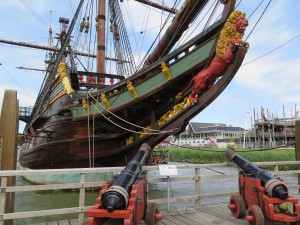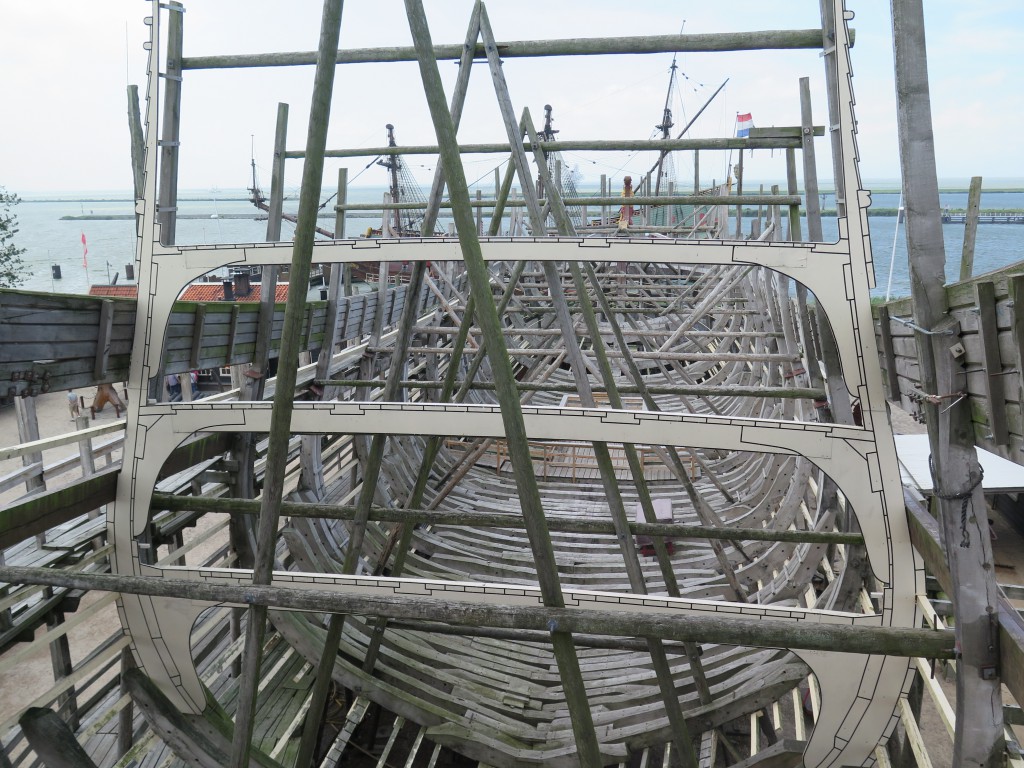
A day off today. Given that it was blowing 25 knots plus outside and the lifeboat was launched this morning, staying in Lelystad looks like it was a good decision.After shopping in the morning, we spent the afternoon at the Batavia Werf. Between 1985 and 1995 a complete replica of the Dutch East India Company ship the Batavia was built at the Batavia Werf in Lelystad. The Batavia (named after Jakarta in the Dutch East Indies) sailed on her maiden voyage from Texel towards the Dutch East Indies. However, she never made it there. A planned mutiny by Jeronimus Cornelisz led to the sheep being steered away from the rest of the convoy and eventually being wrecked on the Houtman Shallows – a group of coral islands off the West Coast of Australia. Around 40 out of a crew of 340 survived and the captain and his first officer went off in one of the ships boats to get help. It took them four weeks to sail to Java. A rescue mission was immediately organised – the cynical amongst us may suggest that this was mainly because of the quantity of gold and silver on board, but this took around 2 months to get back to the islands.
In the meantime Cornelisz (a bankrupt pharmacist from Haarlem) had established a reign of terror and brutally murdered all those who didn’t agree with him. They planned to seize the rescue ship when it arrived. It is thought that he and his fellow mutineers murdered around 125 of the surviving passengers and crew. Luckily the rescue ship was warned of the mutiny by some loyal soldiers and the mutineers were all captured. Following a trial on a nearby island (Seal Island), they were all hanged. Not surprisingly the story of the Batavia became quite infamous in Amsterdam and a copy of the Captain’s book based on the tragedy is in the Rijkmuseum in Amsterdam.
In 1999 the replica Batavia was shipped to Sydney in time for the 2000 Olympics and became the flagship for the Australian Olympic team – an interesting choice in the circumstances.
The shipyard is now building a complete replica of the Dutch Ship of the Line – the ‘Seven Provinces‘. This was the flagship of the famous Dutch Admiral Michiel de Ruyter – a particular thorn in the side of the English as he organised the famous raid on the Medway where the Dutch fleet sailed up to Gravesend and also up the Medway to Chatham. In the raid on Chatham they destroyed three major naval ships and ten others – very embarrassing for the English navy. This raid led to quick end to the Anglo-Dutch war on favourable terms for the Dutch. The Seven Provinces is still very much a skeleton with the keel and all the ribs made, but they are using the project to keep many old skills alive and train apprentice shipbuilders.
Around the ship are the rigging yards, the wood carving workshops, the blacksmiths forge and the sailmakers loft where all the ancillary items for the boat are made and the Batavia is maintained. In the rigging workshop we were shown all sorts of things by an enthusiastic rigger. He showed us various knots, how to make blocks, a grommet, baggywrinkle and also how to worm, parcel and serve the rigging. Apparently though the expense of all three processes has meant that they now just serve the rigging using synthetic materials! It was a fascinating tour and good to see some of these old skills kept alive, albeit in a more modern way.

